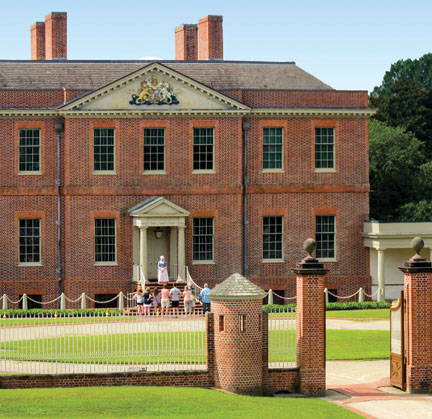On December 5, 1770, the building that would come to be known as Tryon’s Palace officially opened for business. In just a little over three years, Royal Governor William Tryon had been able to accomplish something his predecessors had not: establish and build a permanent capitol for the Province of North Carolina.
Royal governors Gabriel Johnson and Arthur Dobbs had identified the lack of a capital and centralized records as a major obstacle to growth and economic development. Both men had succeeded in choosing locations for a permanent capital, but both died in office before seeing those plans come to fruition.
When he took office in 1765, William Tryon immediately addressed the capital issue. He wrote to London officials, supporting New Bern as an ideal location. When he had come to the province, Tryon had been accompanied by the architect John Hawks. By 1766, Hawks began working on initial plans for an “edifice.” Hawks went to Philadelphia, the largest city on the Atlantic seaboard, to hire skilled labor and purchase materials. Other labor and materials were imported from England.
In December 1767, Tryon approached the Assembly for funding in addition to the original £5,000 appropriated by the General Assembly. The following January, the Assembly voted an additional £10,000. To raise the necessary funds, the Assembly levied poll taxes and charged duties on imported alcohol. New taxes helped fan into flame the smoldering resentment of backcountry residents, contributing to the Regulator Rebellion.
Not even a brewing rebellion, however, could dampen Tryon and the Assembly’s enthusiasm in December 1770 when they celebrated the grand opening of the building. A report published in the Virginia Gazette described “That very elegant and noble Structure the Palace.” The occasion was marked with cannon volleys, bonfires, a ball, and plenty of alcohol. The evening concluded with “a very grand and surprising Exhibition of Fireworks.”
Tryon took the governorship of New York at the end of June 1771. His successor, Josiah Martin, and his family moved into the Palace. After the Martins left under pressure from the coming American Revolution, the General Assembly found the building’s upkeep an endless burden. As early as 1782, the Assembly considered selling the Palace to pay war debt. After the Revolution, the Assembly continued to meet in the Council Chamber, and rooms were rented out for other purposes.
As the building decayed, visitors continued remarking on its tarnished grandeur. On his 1791 Southern Tour, President George Washington was honored with a dinner and ball at the Palace. It was, he noted, a “good brick building but now hastening to Ruins.” In 1794, the capital was officially moved to Raleigh.
By 1798, the building was a shadow of its former self. On the night of February 27, a fire of unknown cause spread quickly through the building. In reports published in newspapers from Maine to Georgia, the ferocity of the flames was evident: “Every piece of timber, and all the wood work of that edifice, both within and without, were consumed.”
By Lindy Cummings, Research Historian, Tryon Palace
Tryon Palace • 529 South Front Street • New Bern, NC 28562 • 252-639-3500 • www.tryonpalace.org

